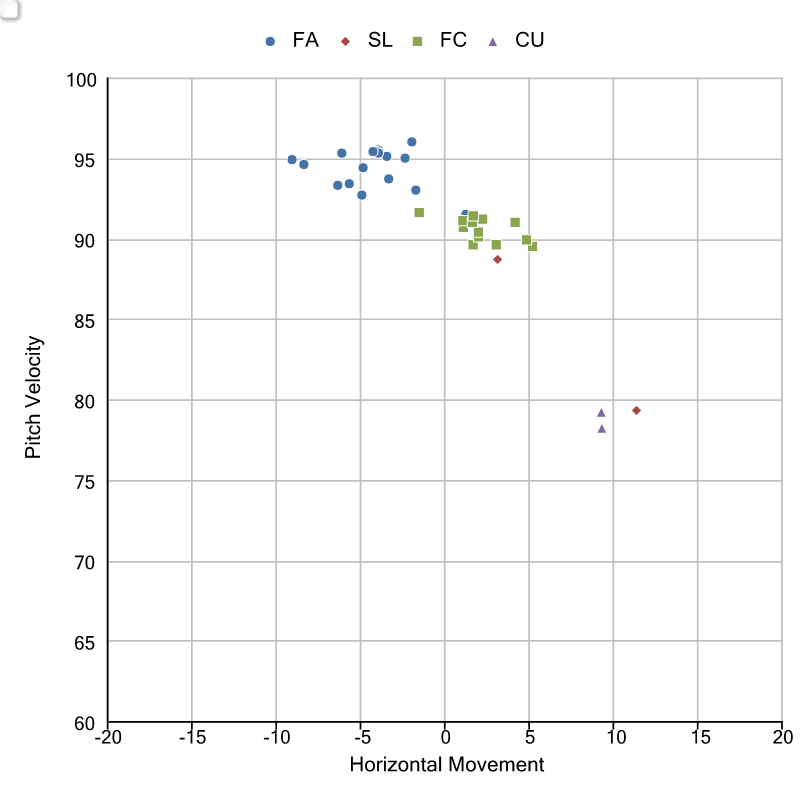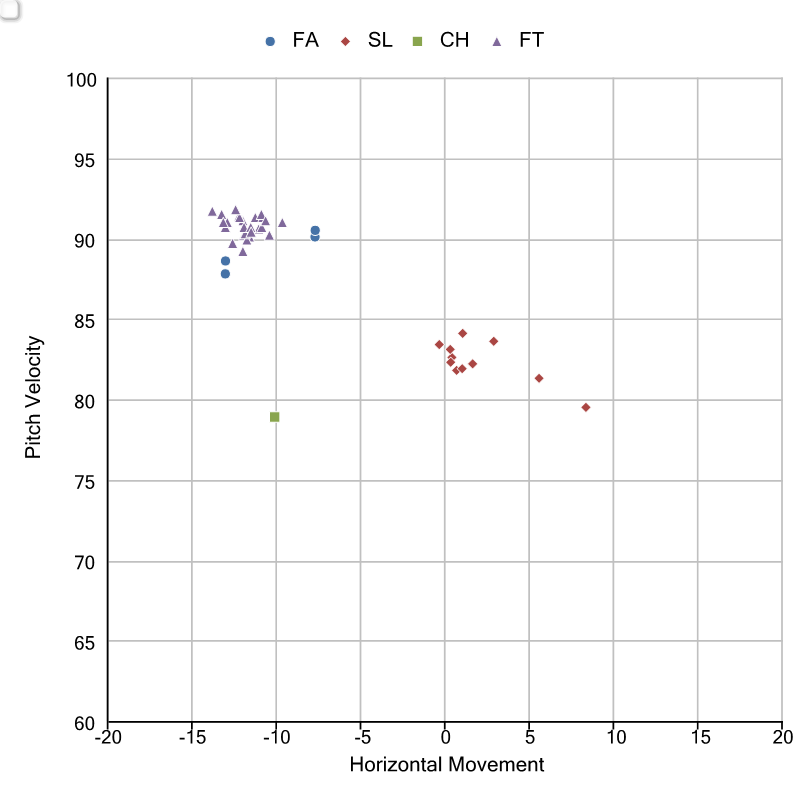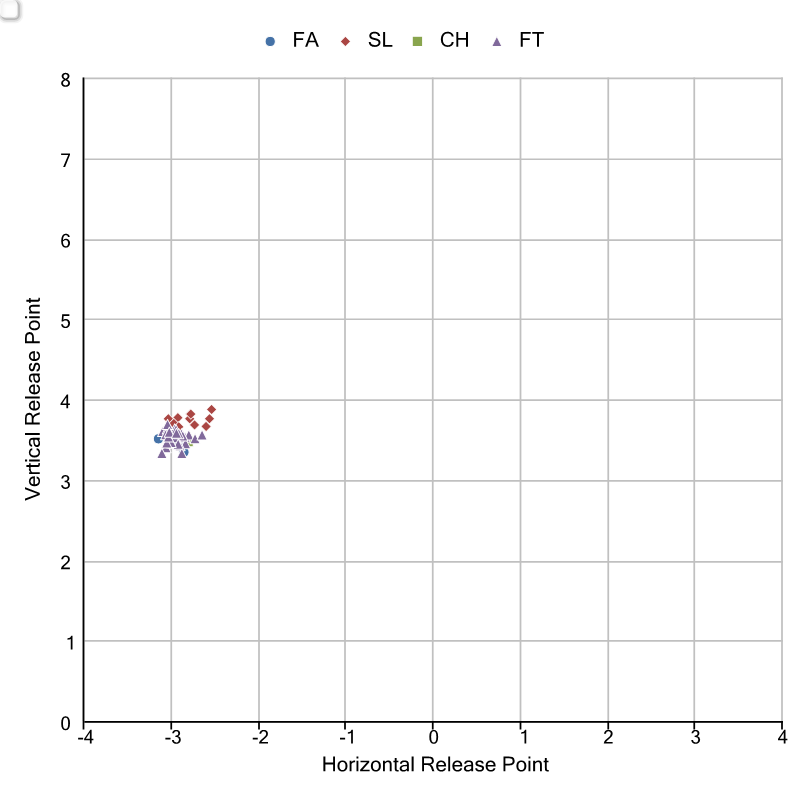A Thing Worth Keeping An Eye On
Danny Farquhar is only in the majors because the Mariners needed an extra arm for the bullpen after Hector Noesi had to be used as a spot starter because of Aaron Harang‘s aching back. Noesi obviously wasn’t optioned to Tacoma because they wanted to get him off the team, and he’ll likely be back as soon as he’s fulfilled the 10 day requirement that goes along with getting optioned out. However, Danny Farquhar might have shown enough in his one outing on Saturday to not be the one headed back to Tacoma when Noesi returns.
No, it’s not because he struck out five of the eight guys he faced in low leverage mop-up duty; it’s because of what he was throwing.
That’s a PITCHF/x plot of the 34 pitches Farquhar threw on Saturday. Forget the labels, as there’s basically three pitches there: a bunch of fastballs from 92-96, some cut fastballs from 89-92, and a few curveballs at 79.
Now, here’s a PITCHF/x plot of the 43 pitches Farquhar threw in the Major Leagues back in 2011, when he was a member of the Blue Jays.
There are three pitches there too, but as you can see, they are not the same three pitches. In 2011, he threw a fastball at 88-92, a slider from 80-84, and a single change-up at 79.
And now, here are those two charts overlayed on top of each other, and you see the changes by moving the mouse over or off the image.
Basically, the Farquhar who pitched in Cleveland on Saturday bears no resemblance to the one who pitched in the big leagues with Toronto, besides the fact that it is the same human being, anyway. That Farquhar was a garden variety sinker/slider minor leaguer, a guy who could get some ground balls against right-handers but was otherwise ill equipped to pitch in the majors. If you’ve ever watched a Triple-A game, you’ve seen 100 relievers just like him. This is the kind of pitchers that make up PCL pitching staffs.
The one that pitched for the Mariners on Saturday, though? A totally different guy. The fastball averaged 95, as he’s mostly swapped out his two seam for a harder four seam fastball — note that his fastest fastball in 2011 was still slower than his slowest fastball in 2013 — while the cutter sat at 91, and he mixed in few curveballs just for fun. And the entire delivery is just completely different.
You can see video of him throwing a pitch for Toronto here, then compare that to with Seattle in the second video. And here’s an overlay of his release points, both for 2011 and 2013.
As you can see, the release point has gotten much, much higher, and he’s now releasing at something close to 3/4 rather than side-arm. Basically, he’s gotten more vertical, and his stuff has taken a big leap forward in the process.
Not only is he throwing four or five miles per hour harder, the cut fastball is just a far better second pitch than anything he used to have, and unlike the slider, it’s not a pitch that has a huge platoon split. On Saturday, he threw eight cutters to right-handers and six of them to left-handers, and it was actually more effective against LHBs, getting two called strikes and a swinging strike.
A guy throwing 95 mph four-seam fastballs, mixing in a 91 mph cutter, and throwing the odd 79 mph curve just to throw hitters timing off – that’s not the stuff of some random dude called up from Tacoma to eat some innings in a pinch. Farquhar was destroying the PCL before he got called up, and after seeing what he was throwing, his dominance down there suddenly makes a lot more sense.
Basically, we can take Farquhar’s mediocre track record and almost entirely toss it out the window. You might look at him as a journeyman who pitched for four different Triple-A clubs last year, but there’s no way anyone would have tried to sneak him through waivers throwing what he’s throwing right now. What he showed on Saturday was the kind of stuff that good relief pitchers are made of. And, perhaps most importantly to the Mariners, he showed that he might be the kind of reliever that doesn’t have to be pulled whenever an opposite handed hitter comes to the plate.
For better or worse, the Mariners have built a bullpen full of slider-throwing specialists. With the exception of Tom Wilhelmsen, pretty much everyone else down there comes in and pounds opponents with sliders, leading to some crazy platoon splits. Carter Capps, Charlie Furbush, Oliver Perez, and Lucas Luetge all lean heavily on their slider and are best used situationally. The same is true of the returning soon Josh Kinney and Stephen Pryor. Whether it’s intentional development or not, the Mariners have seemingly turned out an endless supply of slider specialists the last few years.
Farquhar and Yoervis Medina are exceptions. Medina throws an 85 mph curve as his second pitch, but relies primarily on his fastball to go after hitters, as his curve isn’t a great weapon yet. Farquhar’s cutter looked like a real asset on Saturday, and he was throwing just as hard as Medina, whose velocity kept him on the 40 man for years even when he couldn’t get anyone out in Double-A.
With Farquhar, and maybe Medina to a lesser extent, the M’s now have two guys in their bullpen who might be more than just a platoon match-up specialist. Farquhar showed flashes of being a true middle reliever, the kind of guy the M’s could give multiple inning runs to without worrying about who is due up further down the line-up. Farquhar is much more interesting, and potentially much more valuable, than a redundant left-handed specialist.
If it’s me, Lucas Luetge is the guy heading back to Tacoma when Noesi returns to take the long man spot in the bullpen, and to be honest, I wouldn’t be in a huge hurry to replace either Medina or Farquhar with Josh Kinney any time soon. His rehab assignment is set to expire in 10 days, but I don’t know that adding a 33-year-old who throws a slider 50% of the time is actually going to help a bullpen that needs a real middle reliever. If Kinney throws decently in Tacoma, maybe you make the switch because it’s not a big harm to option Farquhar or Medina back to Triple-A and give the veteran another look, but Farquhar showed more interesting stuff on Saturday than Kinney ever has, and for a team building for the future, it’s probably worth getting a longer look at a kid who might have taken a big step forward in his career.
As a 5’10 26-year-old, Farquhar’s not exactly a franchise building block, but in his first outing, he showed the stuff of a guy who could fill a void in the Mariners bullpen, and maybe be a key middle reliever going forward. While the team didn’t get the results they wanted in Cleveland, Farquhar’s debut couldn’t possibly have been any more impressive.
Comments
12 Responses to “A Thing Worth Keeping An Eye On”
Leave a Reply
You must be logged in to post a comment.




Data like these combined with video evidence are the synthesis of science and baseball.
Thanks, Dave. This was fascinating.
So… he’s short… and with that name… can we start calling him Lord Farquhar of Duloc?
Fascinating, Dave. Farquhar looked sharp to my amateur eye. Nice to see evidence to back it up.
Ditto Banjo and TWK. Sharp analysis. Nice to have one more small bright spot to keep an eye on. Thanks, Dave.
Maybe he can teach Capps and Pryor the cutter and then we’d have a deep (and young) bullpen.
All these young pitchers throwing fastballs and sliders leaves one holding their breath hoping that none of them get hurt (any more).
I know its OT BUT
Would you say the Cleveland series is
The Seattle Mariners 2012 offseason
in a MICROCOSM? or nutshell?
This Cleveland series makes me want to punch myself in the face but it’s good to know this development has emerged.
Dave mentioned how so many pitchers throw sliders. I’ve never gotten why? In high school and college none of us threw them, we all threw curveballs. I wonder if it’s something they teach in the minors or something?
I believe high school coaches tend to discourage sliders because of the high stress on the arm and higher likelihood of injury. The research from the little I glanced at indicates that sliders were more associated with pain and injury.
Good, another asset to trade, or to keep to free up another trading asset.
While in theory he might not need to be taken out against opposite-handed hitters, I have no confidence that Wedge grasps any concept more advanced than “the batter’s a lefty, so let’s bring in a lefty to face him”.
But the article itself is quite interesting. Hopefully Farquhar will still be on our roster when the new front office is brought in.